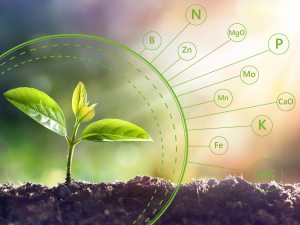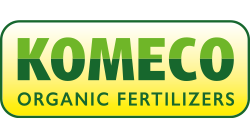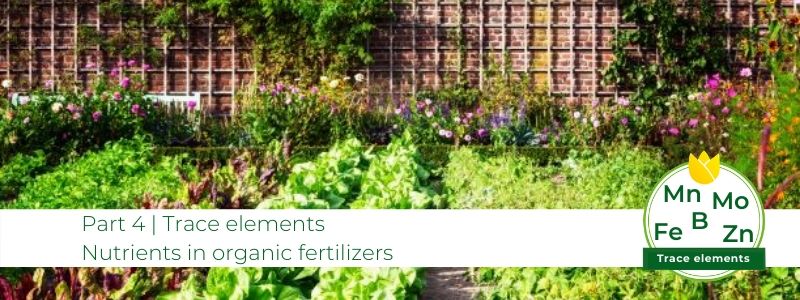Trace elements; the micro nutrients in organic fertilizers (part 4)
In the series of nutrients in organic fertilizers we are reaching part 4. In this part we outline trace elements, also called micro nutrients. What are trace elements? What is the function in organic fertilizers? How do trace elements function in the soil? Last but not least, what do they do for both soil and plant? In this article we will give you all useful information about trace elements and the functions of the different elements in soil nutrition.
What are trace elements?
Trace elements are part of the group micro nutrients (where primary elements are called macro nutrients). Trace elements are located in the nutrition of plants and animals and are necessary for solid growth and the function of (in this case) the plant or crop. A plant needs relatively less trace elements compared to primary elements.
Trace elements always work in combination with other elements, not independent.
They are drivers of many processes in the soil.
The way trace elements collaborate in the plant
Trace elements play an important role for the health of the soil:
- They promote the absorption of nutrients and vitality of the crop and a healthy crop offers a better resistance to diseases.
- Every element of the trace elements has independent functions but they only function together.
- Trace elements participate in the development of different enzymes, hormones, promotion of photosynthesis, improvement of fertility and cell extension and the development of leaf green and strength of cell membranes.
 The different types of trace elements
The different types of trace elements
The main trace elements within organic fertilizers are:
- Molybdenum (Mo); plays a role in the functioning of various enzymes, growth and nitrogen balance of the plant and contributes to the production of various plant hormones.
- Copper (Cu): important for the formation of proteins, vitamins, carbohydrates and enzymes of the plant. Copper strengthens the cell walls of the plant and improves resistance.
- Zinc (Zn): optimes the development of leaf green, stalk elongation and plant veins. The plant will build up better resistance.
- Iron (Fe): plays a role in the production of leaf greenery, respiration of the plant and it contributes to the capture of nitrogen in the roots of the plant.
- Boron (B) and manganese (Mn); most known trace elements which we describe below.
Manganese for photosynthesis and metabolism of the plant
Manganese plays a role in photosynthesis, in many enzymes and contributes to the plants’ metabolism and cell division. Manganese is a building material of, among other things, enzymes. Because of this the plant will becomes stable and strong. In addition, it strengthens the installation of nitrogen in the plant and it strengthens the respiration of the plant. At last, it is an addition for creating strong cell walls.
With a deficiency manganese, the plant can become more susceptible to fungal diseases. A defect causes yellow spots between the veins in the leaf (because manganese is sensitive to acidity (pH). Furthermore a defect reduces the growth of roots and affects the leaf green. A deficient acidity can become toxic. In short, a shortage of manganese disrupts various processes that ultimately impair the development of the plant.
Boron for cell extension, cell division and the production of enzymes
Boron plays a role during the production of cell extension in the roots and in cell division. Boron supports the production of enzymes. These enzymes organize cell division and this contributes to a good development of young shoots. Boron also contributes to the construction of the vessels and the transport system for water and minerals in the plant. The dosage of boron comes narrow, because too much boron can lead to poisoning the plant.
On the other hand, a lack of boron can be caused by a poor soil structure, a surplus of nitrogen and / or potassium in the soil or a too low pH value. At first a defect will arise in the roots and from there minerals cannot be absorbed and transported well. In short, absorption and transport are disrupted and this stops growth. Keep in mind that a boron deficiency resemble a magnesium or nitrogen deficiency, because these minerals will also be absorbed less. It is therefore important to carefully investigate where the defect is formed.
Micro nutrients versus macro nutrients
In organic fertilizers you will find relatively less micro nutrients compared to macro nutrients, like N-P-K and calcium and magnesium. But both are important for different processes and together they all contribute to a healthy soil and higher yield of the crops.
Note for agricultural professionals
Adding organic fertilizer into the soil is therefore important, but the added value varies per soil type. For professional use in agriculture, horticulture and fruit and vegetable cultivation, we advise you to look at what your soil needs together with a fertilizer advisor.
Other nutrients in organic fertilizers
Organic fertilizers keep the soil healthy, the soil life alive and contribute to a sustainable world. Read more about our products and the advantages of using our fertilizers for your soil.



